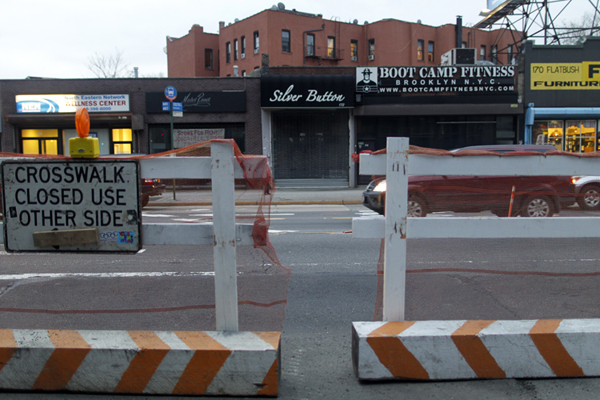
Photo by: Pearl Gabel
Businesses in the area generally look forward to new customers the arena will draw. But they worry about the construction impact they’re feeling now and the traffic troubles that might await.
Though the hardwood in the Barclays Center Arena should be sparkling in time for Brooklyn Nets opening day in September 2012, that is more than can be said for the rest of the Atlantic Yards project. Forest City Ratner’s original proposal included 15,000 construction jobs, 10,000 permanent jobs, 8 acres of open space and 2,250 units of affordable housing, all to be completed over a 10-year span. Due to the rising cost of the project, developer Bruce Ratner has downsized the plan and introduced a new 25-year timetable.
As the opening approaches and the plan evolves, opponents of the project are claiming vindication. Business owners hold out hope for a silver lining amid what they say are mounting problems related to construction and traffic. And supporters or the project are curiously silent. BUILD (Brooklyn United for Innovative Local Development), a group which initially supported the project and accepted funding for job training from Forest City Ratner, did not return phone calls or emails seeking comment. Once billed as a linchpin of community support for the Ratner plan, hasn’t posted a new press released to its website since 2004. Chief Atlantic Yards booster Bertha Lewis has kept a lower profile since the dissolution of the group she led, Acorn (but did talk to Brooklyn Bureau’s Darren Sands.)
Ratner’s chief opponent in the debate over Atlantic Yards was Don’t Destroy Develop Brooklyn (DDDB) co-founder Daniel Goldstein. A resident of one of the properties Ratner wished to claim by eminent domain, Goldstein fought against the project from the beginning. In April 2010, after a lengthy court fight, Goldstein agreed to sell his apartment to Ratner for $3 million. But he’s still opposed to the development, and is not surprised that the reality of Atlantic Yards is failing to match earlier promises. “I never thought the proposed plan was ever feasible,” Goldstein says. “By allowing Ratner to get control of 22 acres of land, he won’t build unless it’s financially feasible to him.”
Indeed, many community dwellers tell City Limits they feel left in the dark by the lack of communication with Forest City Ratner. Community groups continue to push for answers to fill in the gaps. Relations between the developer and the neighborhood have been poor , according to Dean Street Block Association President Peter Krashes. “Ratner is not interested in engaging with the community. They won’t respond to invitations to meetings,” he says. “We don’t know the routes of traffic, the parking situation or how trash will be picked up. The area will be worse than anticipated.”
Forest City Ratner has shared bits and pieces of information with the community regarding the expected timeline and result of the $5 billion project –but most details remain to be seen. With new traffic patterns, noise and a possible heavy influx of foot traffic in the offing, reaction to the project has gone from excitement to dismay for some.
Christian Whitted, 43, owner of New York Chess & Games, at 192 Flatbush Avenue, is ambivalent. “Of course, eventually, it would be great for commerce, but there is a concern of noise pollution, crime and traffic. In fact, they’ve changed the traffic patterns to be less convenient,” he says. “This is now ‘No-Parkslope.’”
Forest City Ratner’s Transportation Demand Management Plan has been pushed back twice and is now set to be revealed in May, which is only four months before the opening of the sporting arena.
“By then it will be too late to change anything,” says Gib Veconi, treasurer of the Prospect Heights Neighborhood Development Council.
The plan’s goal is to discourage visitors from driving. But Forest City is only required to reduce the number of cars in a half-mile radius of the arena, critics say, which means the congestion problem could get pushed further out.
“This is a huge problem for the busiest traffic intersection in Brooklyn,” says Danae Oratowski, chair of the Prospect Heights Neighborhood Development Council. Nor is traffic the only concern. “The promises on open space for the community have not materialized,” she adds. “People have gotten really angry. As we get closer to the arena I know there is going to be a big outcry.”
Still, some harbor optimism. Quiana Di Bari, 36, owner of Va Beh’ at 446 Dean Street, says the stench of construction work is a concern to her Italian eatery. “I think it is uncomfortable, but I am hoping that in the long run the project will be great,” she says.”The smell of the construction work and the noise has been an issue. It’s not appetizing when your customers are trying to have dinner.”







